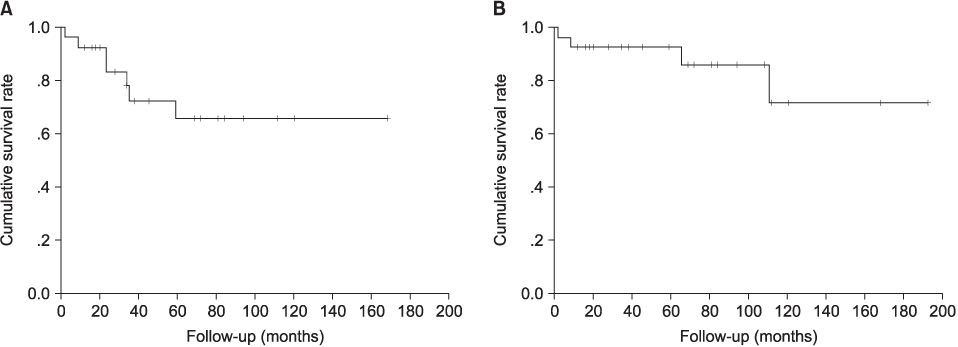Korean J Urol.
2007 Jan;48(1):72-76. 10.4111/kju.2007.48.1.72.
Clinical Experience of 27 Pediatric Renal Transplantation at a Single Center
- Affiliations
-
- 1Department of Urology, College of Medicine, Kyungpook National University, Daegu, Korea. skchung@knu.ac.kr
- KMID: 1915025
- DOI: http://doi.org/10.4111/kju.2007.48.1.72
Abstract
- PURPOSE
Renal transplantation is considered the treatment of choice for children with end-stage renal disease (ESRD). The results of renal transplantation were retrospectively analyzed to assess certain aspects of pediatric renal transplantation.
MATERIALS AND METHODS
Between January 1989 and January 2005, 27 pediatric kidney transplantations were carried out at our center. Fifteen (55.5%) patients underwent hemodialysis, two (7.4%) peritoneal dialysis and ten (37.0%) were conservative managed prior to treatment. Living- related donors provided 25 (92.6%) of the transplanted organs, with cadaver sources utilized for 2 (7.4%) patients. The donor age, organ source, etiology of ESRD, hospitalization period, postoperative complications, occurrence and number of acute rejections, and graft survival were assessed.
RESULTS
The causes of renal failure were chronic glomerulonephritis in 10 patients [IgA 3 nephropathy, 3 membranoproliferative glomerulonephritis (MPGN), 2 nephrotic syndrome and 2 focal segmental glomerulosclerosis (FSGS)], urinary tract anomalies in 6 (4 reflux nephropathy and 2 polycystic kidney), Alport syndrome in 1, hypertensive nephropathy in 2, systemic immunological disease in 1 and unknown causes in a further 5. Acute rejection occurred in 12 patients, all of who recovered after steroid pulse therapy. Growth and development failed in 2 patients. The postoperative complications included 4 urinary tract infections, 3 retroperitoneal hematomas, 2 lymphoceles and 1 acute ureteral obstruction. Four patients expired due to post-operative complications, such as disseminated intravascular coagulation (DIC), intracranial hematoma, sepsis and renal failure.
CONCLUSIONS
Pediatric renal transplantation can be successful, even in young children with ESRD.
Keyword
MeSH Terms
-
Cadaver
Child
Disseminated Intravascular Coagulation
Glomerulonephritis
Glomerulonephritis, Membranoproliferative
Glomerulosclerosis, Focal Segmental
Graft Survival
Growth and Development
Hematoma
Hospitalization
Humans
Immune System Diseases
Kidney Failure, Chronic
Kidney Transplantation*
Lymphocele
Nephritis, Hereditary
Nephrotic Syndrome
Peritoneal Dialysis
Postoperative Complications
Postoperative Period
Renal Dialysis
Renal Insufficiency
Retrospective Studies
Sepsis
Tissue Donors
Ureteral Obstruction
Urinary Tract
Urinary Tract Infections
Figure
Reference
-
1. Grimm PC, Ettenger R. Pediatric renal transplantation. Adv Pediatr. 1992. 39:441–493.2. Patel R, Paya CV. Infections in solid-organ transplant recipients. Clin Microbiol Rev. 1997. 10:86–124.3. Kohaut EC, Tejani A. The 1994 annual report of the North American Pediatric Renal Transplant Cooperative Study. Pediatr Nephrol. 1996. 10:422–434.4. Broyer M, Donckerwolcke RA, Brunner FP, Brynger H, Jacobs C, Kramer P, et al. Combined report on regular dialysis and transplantation of children in Europe, 1980. Proc Eur Dial Transplant Assoc. 1981. 18:60–87.5. Chae JH, Kim MY, Yun IJ, Park HW, Ha JW, Jung SE, et al. Results of 76 pediatric renal transplantation at Seoul National University Hospital. J Korean Soc Transplant. 1995. 9:65–76.6. Sozen H, Dalgic A, Karakayali H, Baskin E, Saatci U, Arslan G, et al. Renal transplantation in children. Transplant Proc. 2006. 38:426–429.7. Kim PK. Renal transplantation in korean children: cooperative study. J Korean Soc Transplant. 1997. 11:217–224.8. Warady BA, Hebert D, Sullivan EK, Alexander SR, Tejani A. Renal transplantation, chronic dialysis, and chronic renal insufficiency in children and adolescents. The 1995 Annual Report of the North American Pediatric Renal Transplant Cooperative Study. Pediatr Nephrol. 1997. 11:49–64.9. Lashley DB, Barry JM, Demattos AM, Lande MB, Mowry JA. Kidney transplantation in children: a single center experience. J Urol. 1999. 161:1920–1925.10. Bosque M, Munian A, Bewick M, Haycock G, Chantler C. Growth after renal transplants. Arch Dis Child. 1983. 58:110–114.11. Kim JH, Kim KS. Clinical analysis of childhood renal transplantation: a report of 28 cases. Korean J Urol. 2002. 43:547–550.12. Emiroglu R, Moray G, Sevmis S, Sozen MH, Bilgin N, Haberal M. Long-term results of pediatric renal transplantation at one center in Turkey. Transplant Proc. 2005. 37:675–678.13. Haberal M, Bereket G, Karakayali H, Arslan G, Moray G, Bilgin N. Pediatric renal transplantation in Turkey: a review of 56 cases from a single center. Pediatr Transplant. 2000. 4:293–299.14. Lee SY, Han H, Park YS, Han DJ. Clinical experience of 60 pediatric renal transplantations at a single center. Korean J Pediatr. 2004. 47:55–65.15. Van Damme-Lombaerts R, Herman J, Coosemans W, Pirenne J. Pediatric renal transplantation: a single centre experience. Transplant Proc. 2000. 32:436.16. Mir S, Erdogan H, Serdaroglu E, Kabasakal C, Hoscoskun C. Pediatric renal transplantation: single center experience. Pediatr Transplant. 2005. 9:56–61.17. Makisalo H, Eklund B, Salmela K, Isoniemi H, Kyllonen L, Hockerstedt K, et al. Urological complications after 2084 consecutive kidney transplantations. Transplant Proc. 1997. 29:152–153.18. Samhan M, Al-Mousawi M, Hayati H, Abdulhalim M, Nampoory MR. Urologic complications after renal transplantation. Transplant Proc. 2005. 37:3075–3076.
- Full Text Links
- Actions
-
Cited
- CITED
-
- Close
- Share
- Similar articles
-
- BK polyomavirus infection following COVID-19 infection in renal transplant recipients: a single-center experience
- Split liver transplantation for one adult and one pediatric recipient: A collective review of Korean experience
- Clinical Experience of 60 Pediatric Renal Transplantations at a Single Center
- Pediatric kidney transplantation is different from adult kidney transplantation
- Pediatric liver transplantation in Korea: long-term outcomes and allocations


